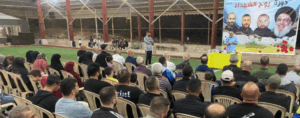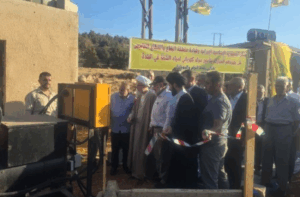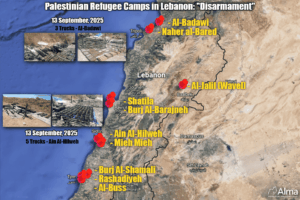Brigadier General (Res.) Shachar Shohat, Vice President of Strategy at Rafael’s Air Defense Systems Division and former Commander of the Air Defense Corps
Yair Ramati, Chairman of RSL, Former Head of the IMDO (Israel Missile Defense organization) “Homa” Directorate at the Ministry of Defense and Former Vice President of Marketing at IAI
Historically, ground and naval forces used smoke signals, pigeons, flags, and Morse code to coordinate during battles. Today, with advanced technology, complex battlefields, airpower, precise weaponry, and intelligence, interoperability (connectivity) has become crucial in military operations. Modern air combat depends heavily on data networks linking manned and unmanned platforms, missiles, air defense systems, spaceborne assets, and more.
The terms “connectivity” and “interoperability” encompasses multiple layers: From armament, platforms, units, and branches (sea, land, air, space, cyber, and others) to integration with neighboring countries or global powers operating in the arena. The latter is commonly referred to as “regional air defense.” This article will focus on the connectivity and interoperability layers of air defense systems alone.
What Does the Term “Interoperability” Mean?
NATO has chosen a simple definition: the ability to operate efficiently and in coordination while deploying forces in the battlefield. In the United States, the perceptions are more complex and delve into professional domains.
In practice, and with a certain degree of simplification, it involves the integration and fusion of information from various sensors, weapon systems, command and control mean with various countries to create an accurate and coordinated air situation picture. This shared or a Single Integrated Air Picture (SIAP) forms the foundation for air defense, air warfare , and even naval combat. It enables efficient engagement management and intelligent resource allocation based on reliable target identification. This is essential in a dense environment where “blue,” “red,” and civilian airborne platforms operate together in the very same airspace.
In Israel, the interoperability (connectivity) has evolved from a simple one-way satellite alerts during the Gulf War to complex multi-nation operations. In the recent large-scale conflict with Iran (or their proxies) such as April 14th, 2024, October 1st, 2024, and recently “Rising Lion” operation (June 2025) fighter jets, Israeli interception systems, and the U.S. Sixth Fleet worked together seamlessly, and coherently showcasing advanced operational and technological interoperability.
What Has Driven Interoperability (Connectivity) in Its Current Form Over the Last Decades?
The answer lies in the combination of operational, technological, and cultural-conceptual developments.
Aerial network connectivity has evolved in both civilian and military channels. In the civilian sector, it enables the tracking of aircraft and expected flight paths from various sensors, including data from the aircraft itself via satellite and self-navigation. This is no longer just a voice network but an integration of airborne and ground data available to all consumers and presented in a coherent manner. Its significance is great in several respects, especially safety. In the future, as civilian UAVs and other transport vehicles evolve, it will also be used for monitoring low altitudes.
In air combat, distributed systems now use smart, secure networks like Link-16 with manned platforms. Sensors, intelligence infrastructures, air defense systems, and weapons data links have been integrated. Enhanced interoperability and sophisticated operational concepts have boosted air force effectiveness, especially in the Western world and Israel. The air interoperability revolution has led to significant technological, operational, and multinational progress.
A prominent example of implementing connectivity at the platform level is the F-35 fighter jet, whose design is based on the most meticulous implementation of connectivity. Some also point to various naval platforms and attack systems as applying the best capabilities of modern interoperability technology, both for strikes and “target hunting.”
The Need for interoperability in Air Defense Systems
Air defense systems globally operate on core principles such as detection, tracking, identification, and engagement. These systems also issue alerts, enforce Anti-access/Area Denial (A2/AD) measures, conduct soft warfare, among other functions. The enhanced effectiveness of modern air defense systems and their high detection and interception rates are predominantly dependent on robust identification and interoperability.
Indeed, one of the reasons for relatively low interception rates of attacking UAVs in Israel under “Iron Swords” lies in the weakness of the kill chain, particularly in detection, tracking, and identification.
As air defense systems become more efficient and lethal, two key elements become clearer: the first is accurate identification – avoiding the downing of friendly aircraft.
For example, the December 2024 incident in which a U.S. F-18 was shot down by “friendly fire” during an operation in Yemen against the Houthis. The second aspect is the ability to rapidly evaluate the outcome of the interception, known in professional terminology as KA (Kill Assessment), which allows for the immediate launch of another interceptor to prevent any incoming threats from breaching defenses.

“Rising Lion” operation (June 2025) – lower layer interception systems fires interceptors in coordination with the upper tier system. Photo taken from social media.
interoperability Challenges
The challenges involved in designing national level interoperability capabilities are numerous. The main challenges include:
- Managing diverse sensing systems, weaponry, and interceptors – each system produces slightly different data. For example, radar transmitting 3D data cannot be treated the same as an optical sensor with 2D data or a satellite producing a completely different type of data. Technologically, the ability to extract meaningful information from various sensors with different accuracy profiles and varied timestamps is a complex challenge. Additionally, it necessitates striking an appropriate balance between optimization, resilience, and the potential costs associated with incorrect identification or self-interception.
- Integrating cybersecurity measures and the ability to deal with related challenges in real-time. It is essential to ensure that penetration into one part of the network (sensing, communication, or firing) does not expose the entire system to the enemy. Therefore, protections (such as firewalls) need to be flexible and sophisticated.
- Information classification and handling of sensitive intelligence sources are critical aspects of managing the air picture, which often contain sensitive details such as operational schedules, flight paths, and databases of enemy armaments and allied forces. To prevent exposure of sensitive information through a breach at one of the end stations, the data transmitted via the connectivity network must be secured. This necessitates the implementation of information hierarchies, compartmentalization, asymmetry, and occasionally unidirectional data flow.
Additional Layers in Implementing the Interoperability Concept
The benefits of advanced algorithms, powerful computing, and fast communication and security systems can sometimes become a curse. Technology enables (Enable Technology) air defense systems to head in different directions, but to become effective, they must adhere to a clear, up-to-date operational compass reflected in the design of appropriate doctrines and relevant operational procedures.
These end-systems require shared and detailed operating procedures, and if foreign partners are involved, these will be written in English and tailored to the partner’s or neighbors’ systems. The next step in operational implementation involves joint training and potentially even the formation of joint operational teams along with agreed detailed procedures.
Training and exercises are required not only during the initial deployment but also throughout the system’s lifecycle, with the addition of software layers and new capabilities, to ensure efficient technical-tactical implementation.

The CENTCOM chief also discussed ongoing efforts to enhance the interoperability of U.S. and Israeli forces, while reiterating the robust military-to-military relationship between the two countries, according to a U.S. Central Command press release.[1]
Summary and Conclusions
Air defense systems worldwide have come a long way from the days of Vietnam, the Six-Day War, and Yom Kippur (“the missile bent the plane’s wing”) to today. In the past, air defense systems (then called “anti-aircraft” or ADA “Air Defense Artillery”) dealt only with aircraft, achieving success rates of just a few percent, which were deadly enough for fighter fleets making repeated sorties.
In recent years, air defense systems globally have been tasked with addressing a wide range of platforms and munitions, including drones and stealth aircraft, while achieving interception success rates tenfold higher. Data from the past decade confirms that these objectives are being met.
A crucial factor contributing to this success is interoperability. Air defense, especially in Western countries and Israel, depends significantly on interoperability infrastructure. This encompasses establishing a reliable and continuous air surveillance system, efficient target allocation, collaboration with regional allies—including neighboring nations and the United States—and intelligent interception management. When effectively implemented, interoperability ensures operational success and economic efficiency through sophisticated interception management, optimal resource allocation, enhanced safety, and minimal false alarms.
Maintaining these achievements, as part of the arms race between Israel and the Iranian axis, requires the nurturing of Israeli air defense capabilities with interoperability at its core.
** The article was also published in a shortened version in
[1] https://www.jns.org/centcom-commander-visits-israel-reviews-operation-rising-lion-success/





